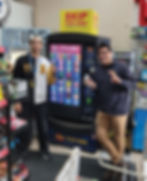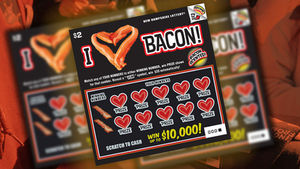Fifty Years of Winning for Ontario
- Insights Online
- Sep 8
- 11 min read
Updated: Sep 9
Ontario’s lottery industry began in 1975 with the game “Wintario,” and after 50 years, the organization now responsible for multiple forms of gaming and entertainment continues delivering wins for the province and its people.
By Patricia McQueen
Published September 9, 2025

As members of the North American lottery industry descend on Niagara Falls this month for the NASPL Annual Conference, their host is one of the most comprehensive and innovative lottery and gaming organizations in the world. An organization that has been included on Forbes’ list of Canada’s best employers four years running, and that has also been named a top employer for diversity and for social responsibility. An organization that in 50 years has collectively raised $62 billion for the people and the province of Ontario to support key government priorities like health care, the treatment and prevention of problem gambling, and support for amateur athletes. That doesn’t even include support provided by its operations to benefit lottery retailers, gaming host communities, Ontario First Nations, and local charities across the province.
ADVERTISEMENT
All this – and more – has been the impact that OLG (Ontario Lottery and Gaming Corporation) has had over the years, while providing an increasing variety of gaming entertainment options for adults who want to play. From its 100% lottery roots as the Ontario Lottery Corporation grew sports betting and casino gaming operations, a variety of online offerings, modernized bingo for charitable gaming centers, plus other programs designed to improve overall revenues for the charitable gaming sector and provide long-term funding for the horse racing industry. OLG was formed when the Ontario Casino Corporation (which began in 1994) was merged with OLC in 2000 to provide a single entity for all gaming in the province.
Those lottery roots began in 1975 with the launch of the passive game Wintario, initially with bi-weekly drawings. The first was held live on May 15, 1975, and for 15 years live drawings were held at locations throughout Ontario. Proceeds were designated for worthwhile community and recreational projects. “OLG’s first lottery game, Wintario, started it all, bringing excitement to communities and laying the foundation for the impact we’ve made across the province,” said Duncan Hannay, President and CEO of OLG, in the June press release highlighting some of the promotions and activities scheduled this year. The ongoing celebrations honor that first game, with the overall theme “Welcome to Wintario” and a variety of games and contests, plus a ramped-up schedule of community events. “With 100% of our profits staying right here in Ontario supporting priorities like health care, amateur sport, charities and more, every play with OLG is a winning one. To say thank you to the players and communities that have been part of our legacy, we’re delivering even more wins to Ontario this year.”
ADVERTISEMENT
The celebration kickoff began in late June with Wintario50, the third limited-run, raffle-style lottery game OLG has recently introduced. It was joined by a second-chance opportunity, the Wintario50 Community Contest, which gave players a second chance to win a $5,000 prize and provided prizes from $5,000 to $250,000 for United Way regions throughout the province. Together, they showcased both prize opportunities for players and the tangible revenues provided to a local charity organization.

Ongoing Game Innovation
Wintario50 is a sample of the game innovations OLG is known for; in this case, short-term products (typically seven to nine weeks) that are quicker to market to provide new variety for players. They have a core set of functionality and can be tweaked for each release, explained Kim Clark, Vice President of Lottery and Customer Success. “Raffle-style games have gained a lot of credibility in this marketplace and are well-known to lottery players. The guaranteed prizing and the short-term nature of the games make for a compelling call to action.”
While these games are designed purposely to help drive demand, they are also important to help learn more about what consumers want, Clark emphasized. “Does a short-term game make a lot of sense in the portfolio, or does it need to be something longer? Eventually, maybe we will launch a long-term product that looks something like this product – it gives us a great testing opportunity.” One downside to short-term games, of course, is the marketing spend necessary to promote each new version.
ADVERTISEMENT
The added charitable component of Wintario50 provides another testing opportunity. While OLG returns its revenue to the provincial government to provide important services, it can’t highlight specific programs or causes those revenues support. In contrast, the Community Contest for Wintario50 creates prizes that go directly to United Way organizations in local communities.
The willingness to try new things has often born fruit. OLG introduced the Watch ’n Win category of games with Poker Lotto in 2010. It was the first game in Canada to offer both instant in-store wins and nightly drawings for even bigger prizes, and it remains in the market today. Another, Megadice Lotto, also has staying power, having launched in 2012. And just this past May, OLG introduced Powerbucks Wheel of Fortune, with an industry first – a progressive jackpot fed not only from OLG lottery sales, but also from participating slot machine and iCasino games across Canada. The Powerbucks jackpot begins at $1 million and grows until hit through one of the participating games. With the strength of the Powerbucks brand (from IGT) known across North America, OLG’s lottery game had a very strong start, well ahead of projections in the early weeks.
The Watch ’n Win concept has even migrated to the instant ticket side of the business. Ontario has offered instant games where one prize involves playing an animated video at any lottery retail location; if that prize is revealed on the ticket, there’s a guaranteed win at retail. Playing the video at retail can also lead to a third prize opportunity involving participation in a live event. The most recent iteration in this category, Money Machine, follows games like Big Spin, Bigger Spin and Plinko. The $5 Money Machine offers instant-win prizes of $5 to $5,000, plus a Money Machine prize determined by the animated video. Any ticket with a Money Machine prize wins a guaranteed prize ranging from $10 to $10,000 or a chance to win from $25,000 to $100,000 by participating in a Money Machine Live Event. Winners of the Live Event prize enter the “money machine” and try to grab as many Money Machine bills as possible in 30 seconds.

All of the Watch ’n Win games, whether sold on a lottery terminal or beginning as an instant ticket, are designed for a slightly different consumer than standard games that offer instant wins. “They’re for someone who wants the thrill of anticipation and actually enjoys waiting. In this type of play, they can elongate their experience,” said Clark.
And then there is Lightning Lotto, which OLG introduced in 2020 with considerable success. It is the first draw game where the winning numbers are drawn first, and players purchase tickets trying to match those numbers. Lightning Lotto provides instant gratification on the draw side of the portfolio.
Watch ’n Win games to date have been retail-focused, but other recent innovations address the need for omnichannel products. For example, a recent crossword instant game had an online bonus play component, and it did exceptionally well. Other developments are under way, with different types of bonus rounds and fully digitized games tied to paper schemes. “We look forward to the digitization of the paper ticket experience for those who want a new and more engaging experience online.”
ADVERTISEMENT
Other Game Developments
Canada has two big national lotto games that grab the headlines and often generate significant jackpots. Unlike their neighbors to the south, though, the Canadian games – Lotto Max and Lotto 6/49 – can account for 35%-40% of sales of traditional lottery products, versus the 10%-12% or so that Powerball and Mega Millions combine to generate in the U.S.
Yet it’s always a challenge to manage jackpot games that depend heavily on, well, the size of the jackpot. Especially when there are changes in consumer preferences. The OLG team is noticing that not as many players “jump onto the bandwagon” these days when the jackpots get really big. That means doing more store-level promotions to help with impulse purchases at the point of purchase. Yet even that doesn’t always work as well as it used to, and both big national lotto games are still trending down and need regular attention.
A 2022 change in Lotto 6/49 helped stem the decline that game was seeing, but “we’re already back in conversations about how to make that game more successful,” noted Clark. Next spring will bring changes to Lotto Max, which will reflect some of the current insights gleaned from research. Importantly, players are showing a slight trending preference for more prizes at lower levels. “We also know the perception of winnability is lottery’s biggest barrier to play – and customer satisfaction.” So the goal will be to provide more smaller prizes in an effort to have more winners, and to create better content for winner stories in the national game category. There will still be big jackpots, of course – after all, these games still provide a significant level of sales, and jackpots will always be attractive. Based on observed changes in the market, however, “winnability, or credibility if you will, in the lottery category is one thing that is important to keep our eye on.”
OLG’s own draw games, sold only in Ontario, help in that regard. “We have better control over these games in terms of making changes, profitability is still strong and we can generally get them quicker to market.”
Instant tickets also play an important role, although historically they have been a much smaller part of the lottery portfolio in Canada compared to the U.S. – averaging around 31% of traditional lottery sales in Canada versus about 62% in the U.S. in FY24.
Ontario has had record instant sales in each of the past five years, despite the general challenges with retail foot traffic everyone faces. Once again, consumer insights drive the portfolio, from the type of games to the frequency of introduction to the price points offered. OLG is one of a few lottery organizations that have introduced a $100 instant ticket, and now there will always be at least one in the market. Also doing well are $50 games. “We’ve seen a little increase in spend per player as they move up the price chain and look for variety and more value with higher payouts.”
ADVERTISEMENT
Retail Impact
Clearly OLG has emphasized retailers in many of its innovative game designs, and retailers are also at the heart of specific game promotions. The organization has had recent success expanding its retail network; currently there are about 10,000 lottery retailers. Most of them are convenience stores, and many are key accounts representing some of the bigger chains throughout Ontario. “Our retailers are our customers, so they are included in our whole ‘customer experience’ focus,” said Clark. “We make sure they have what they need to be successful, and that includes partnering on promotions and other programs, or offering bonus commissions on the sales of new products.”
She’s optimistic that the retailer network is increasing, especially with different types of retailers to help capture the younger adults who are perhaps more elusive and not visiting convenience stores. “We’ve been able to add some new accounts recently, for the first time in years.” New lottery retailers include casual and quick-service restaurants, and importantly, the Canadian Dollarama chain. That chain has more than 600 locations in Ontario alone.
A key to attracting some of these types of retailers is the addition of the latest self-service terminals. They enable full-service lottery products to be sold without the traditional retailer terminal and the complex requirements for instant ticket sales. OLG launched a pilot program at 140 locations in February 2024, and six months later began the installation of 1,400 SSTs across the province.

Another possible way to reach new types of retailers is through the use of QR codes, either at more traditional retail locations or in places that normally wouldn’t support lottery sales. On the testing horizon is a “tap to play” solution where a QR code would be a digital entry point in a retail setting. A player would make a few selections, attest to age and fitness to play, and purchase a ticket delivered directly to their phone.
“We have to go to where the people are instead of expecting them to come to the traditional channels,” explained Clark. That’s part of OLG’s “player of the future” strategies, because younger generations are often not choosing to shop in C-stores and the places where lottery tickets are typically sold. “As we think about the retail environment and how it’s changing, and how we can meet our players where they are, there might be some great opportunities.”
ADVERTISEMENT
360-Degree Marketing
With product and retail development continuing in high gear based on consumer insights, OLG’s marketing engine is also adapting. Lottery marketing efforts are divided between the company’s digital division – where both casino and lottery products reside – and its retail lottery products. “It was so critical to build a terrific online experience,” noted Clark, so that side of the business needed a dedicated marketing team. Acquisition and retention are the driving forces in the digital marketing world, and the OLG team is constantly learning about the likelihood of lottery players to participate in casino or sports betting activities – and vice versa. “Typically those players are different, but there is lots of crossover, so the cross-sell efforts, the testing and the learning all become really important because we want them to stay in our ecosystem.”
On the retail lottery front, the marketing focus is primarily on the national lotto games, which create awareness for the entire product line. There is always big news to carry with four drawings a week between Lotto Max and Lotto 6/49. That keeps things fresh, and it’s up to the retailers to upsell their customers across different lottery products. On the instant side of the business, there’s a shift away from a regular marketing focus on specific games and towards marketing the games as a category. “We want the instant category to start speaking across the board to more customers, which again helps our retailers.”
One thing OLG has learned is that instant players generally expect a different experience than lotto players. They want smaller wins and better odds – winnability is important. For lotto players, however, it’s more about the big dream than winnability.
Those insights wouldn’t surprise anyone, but they are useful when used appropriately. It means that traditional instant players may be more interested in online games, for example. “Differentiations like these help define the various game categories, and even help OLG in its cross-marketing efforts across product lines.”
ADVERTISEMENT
Challenges and Opportunities
In one real sense OLG competes with itself, offering a variety of products that typically attract only certain segments of the population. The external competition increased significantly when the provincial government created iGaming Ontario in 2021, charged with establishing a fully-regulated online gambling market with the goal of bringing the world’s best operators to Ontario in order to provide safer environment for players. The first operators began in April 2022.
During the most recent fiscal year, ending last March 31, the regulated private iGaming market produced $82.7 billion in wagers and $3.2 billion in gross gaming revenue. The iGaming operators pay a 20% tax on that GGR; during FY25 there were 49 gaming operators operating 84 different gaming sites. For comparison, OLG’s entire operation generated $6.7 billion in GGR in FY25.
There’s not only new competition from the private online gambling sector, as there’s also an increase in the number of charities offering lottery products, and hospital lotteries are also gaming traction. “We’re seeing 12% of our customers every month now buying charitable lottery products,” said Clark.
The OLG team monitors all of this activity looking for what drives consumer behavior and what OLG can do better, or differently. Certainly that helps drive game innovation across the company, and also drives constant improvement in the customer experience.
ADVERTISEMENT
“It used to be that you could introduce a new game with a different kind of prize, and people would buy it. That’s not the case anymore. The whole user experience, on the retail side but even more so on the digital side, is critical. We really need to think about who the people are that we could bring into the ecosystem, and what they are looking for. If we don’t center our innovation and our thinking around that new player and how they might interact with us, then we will be missing a very big boat.”
Clark is very enthusiastic about the future on all segments of OLG’s business. Innovations for both the retail lottery and casino businesses are a continuing focus, and the digital side of the business (lottery, casino and sports betting) – is thriving, with active players doubling in the last couple of years even as the competition increased. “It’s all about creating better experiences for our players, including better live experiences. All of our cylinders are firing, and we’ve done a lot to move the needle quite significantly during the tenure of our current leadership. It’s great to have to think differently to meet the consumer and reinvent ourselves in such a way that we’ll meet all challenges.”












































